Terror in a Texas Town Blu-ray Movie
HomeTerror in a Texas Town Blu-ray Movie 
Arrow AcademyArrow | 1958 | 81 min | Not rated | Jul 11, 2017
Movie rating
7 | / 10 |
Blu-ray rating
| Users | 0.0 | |
| Reviewer | 3.0 | |
| Overall | 3.0 |
Overview
Terror in a Texas Town (1958)
A Swedish whaler is out for revenge when he finds out that a greedy oil man murdered his father for their land.
Starring: Sterling Hayden, Sebastian Cabot, Carol Kelly, Eugene Mazzola, Nedrick YoungDirector: Joseph H. Lewis
| Western | 100% |
Specifications
Video
Video codec: MPEG-4 AVC
Video resolution: 1080p
Aspect ratio: 1.85:1
Original aspect ratio: 1.85:1
Audio
English: LPCM 2.0 Mono (48kHz, 24-bit)
Subtitles
English SDH
Discs
Blu-ray Disc
Single disc (1 BD)
Playback
Region A, B (C untested)
Review
Rating summary
| Movie | 3.0 | |
| Video | 4.0 | |
| Audio | 3.0 | |
| Extras | 1.5 | |
| Overall | 3.0 |
Terror in a Texas Town Blu-ray Movie Review
Where's Captain Ahab when you really need him?
Reviewed by Jeffrey Kauffman July 20, 2017Two of the supplements included on this new Blu-ray release of Terror in a Texas Town repeatedly refer to director Joseph H. Lewis as “a stylist without a theme”. That might be an almost backhanded compliment in a way, alluding to a quality that otherwise might be simply called “versatility”, but the implied subtext is that while many of Lewis’ films have directorial flourishes galore, there’s not much “there” there to support all of those “bells and whistles”. Lewis was a journeyman director who is chiefly remembered these days for his noir (or at least noir-ish) entries like Gun Crazy and The Big Combo, but his filmography, while not overly vast, includes a number of interesting productions in an array of genres, such as Bela Lugosi’s first foray into the “poverty row” environment of Monogram Studios, Invisible Ghost, as well as Bombs Over Burma, a “war film” featuring Anna May Wong that features an unusual context and perspective, but which, like many of Lewis’ efforts, was hampered by a near non-existent budget. Lewis is also credited with directing the production numbers of a higher profile musical property, the multi-Oscar nominated (and winning) The Jolson Story. Lewis also directed one of my personal favorites from the 1940s, the creepy mystery My Name Is Julia Ross which later served as the source for Dead of Winter. Even this massively abbreviated list may tend to put the lie to the fact that there’s no “content” underlying Lewis’ unmistakable visual style, but Lewis’ last feature film, 1958’s Terror in a Texas Town, is a really bizarre combination of hoary Western tropes mixed with sometimes completely outré elements that few would expect to find in an “oater”. The fact that the film’s marketing campaign promised both “Iron Hooked Fury!” as well as “harpoon against six gun” may indicate at least one way in which Terror in a Texas Town subverts traditional Western formulations, but there’s a slightly anarchic quality to the film which at least hints at something deeper going on than some of the surface shenanigans may suggest.
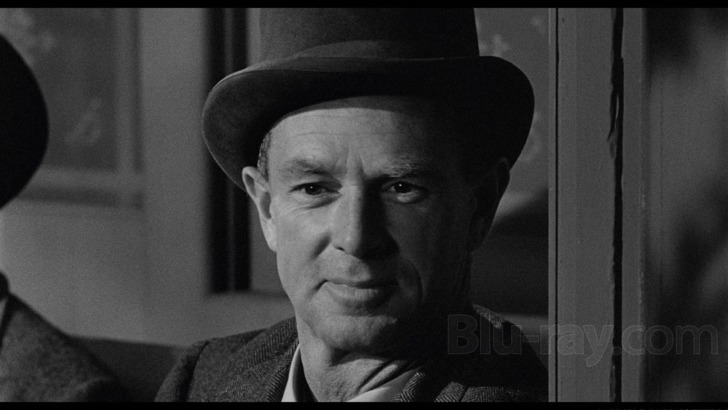
Terror in a Texas Town was written by the then still blacklisted Dalton Trumbo (fronted by Ben Perry), and while there is the typical Trumbo subtext to some of the goings on in the film, at its most basic the story is a simple tale of a washed up gunfighter (the villain, in this case) and a kind of High Noon-esque ambience that pits a newcomer to town against the bad guy, and the bad guy’s impudent mentor. The newcomer is George Hansen (Sterling Hayden), the partially paralyzed gunfighter is Johnny Crale (Ned Young) and the chief schemer behind what amounts to a gigantic land grab is the one-named McNeil (Sebastian Cabot). The film is bookended by a sequence which details Hansen approaching Crale on a typical Western town’s “main drag”, with Crale armed with six shooters and Hansen armed with, yep, you guessed it, a harpoon. That opening tease (which of course recurs at the film’s ultimate showdown denouement) may be enough to rope in viewers who will otherwise be less thrilled with some of the more rote elements of the plot.
Those rote elements include an opening scene which involves McNeil’s henchmen burning down a farm that is on land McNeil has his eyes on, but interestingly, interspersed with stock footage Lewis provides two extreme close-ups of the couple supposedly left homeless and bereft after the tragedy, something that personalizes the moment and reflects Lewis’ attempts to make this pretty hoary saga have a little emotional impact. When there is dissension among the ranks of the farmers in the wake of this event, Sven Hansen (an uncredited Ted Stanhope) vows to protect his holdings come hell or high water. While it’s never really adequately explained, a Mexican cohort named Jose Mirada (Victor Millan) seems to have some sort of history with Sven and he vows to follow Sven into battle. When it turns out the Hansen property may be even more valuable than Sven had considered, a showdown with Crale is unavoidable, leading to another harpoon vs. gun skirmish that leaves Sven on the losing end.
Sven’s son George arrives in town, but finds everyone, including the sheriff (an uncredited Tyler McVey), curiously circumspect about his father’s recent death. Meanwhile, it’s been detailed that Crale is suffering from a debilitating disfigurement, one that seems to presage his eventual “retirement”, whether he wants that to happen or not. Crale’s main squeeze, a kind of forlorn floozy named Molly (Carol Kelly), seems to sum up Crale’s lot in life by mentioning that the only reason she stays with him is because his lowly status makes her feel better about herself. (The film is really kind of oddly devoid of focal female characters, with no obvious “love interest”, at least for putative hero George, and with only a couple of other women with speaking roles in the cast in any case.)
There are certain logical inconsistencies at play in the screenplay which are more or less papered over, but which may still bother more persnickety types. The first meeting of the farmers and ranchers, after McNeil’s arson at one of the townfolk’s abodes, seems to suggest they had all banded together to fight McNeil, and yet some seem to think McNeil actually has legal standing to take their land. This is never really developed or even followed up on, so that when George arrives on scene, everyone’s state of denial about what’s going on seems positively weird. When George is able to almost miraculously get everyone to at least follow him (if not to actively participate) once he’s hell bent on confronting Crale, that seems like another quantum leap in motivation that’s never really adequately explained.
While the film really doesn’t have much going for it in terms of actual suspense, the characterizations are quite interesting, maybe even fascinating. George, despite his he man past, comes off as something of a dandy, perhaps emotionally ill equipped for life in the “wild west”. Crale is positively sociopathic, clad all in black and sporting what amounts to the 19th century equivalent of a bionic hand. McNeil is oddly both patrician and completely feral, and Cabot provides a good deal of the film’s weird energy with his performance.
Still, it’s at least arguable that the most riveting “performance” in the film is Lewis’. As is discussed in the two featurettes supplied as supplements on this release, Lewis’ stylistic proclivities are fully on display throughout the film, even when content perhaps doesn’t dictate them to be. His sobriquet “wagon wheel Joe” gets another workout here (see screenshot 3 for an example), but his framings are often kind of askew, lending a subliminal feeling of angst to what are otherwise somewhat pedestrian sequences. The use of a harpoon to battle a six shooter may be a completely unique hook (sorry, couldn’t resist), but it’s Lewis’ directorial acumen that really provides the allure here.
Terror in a Texas Town Blu-ray Movie, Video Quality 
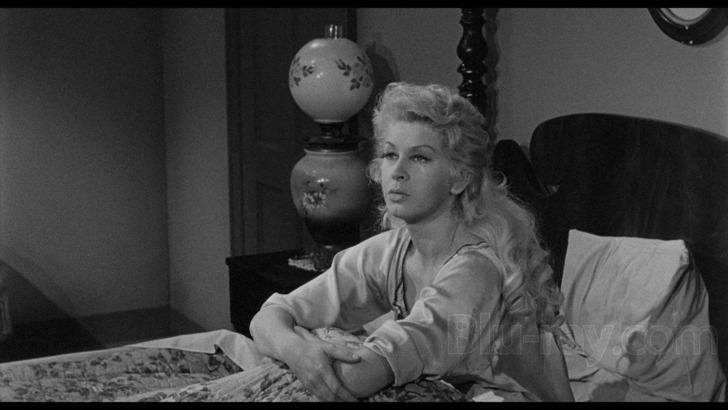
Terror in a Texas Town is presented on Blu-ray courtesy of Arrow Academy with an AVC encoded 1080p transfer in 1.85:1. Arrow's insert booklet contains the following information on the transfer:
Terror in a Texas Town has been exclusively restored in 2K resolution for this release by Arrow Films. The film is presented in its original theatrical aspect ratio of 1.85:1 with mono sound.With an understanding of the source elements utilized, this is a largely stellar looking restoration, with excellent contrast, solid black levels and generally nice detail levels. There are occasional moments that have slightly "dupey" appearances, including the bookending sequence (which, considering its reappearance in the film, is understandable) as well as equally understandable use of stock footage (see screenshot 19). Grain resolves organically virtually all of the time, but spikes a bit in the aforementioned dupe-like moments. Lewis, along with DP Ray Rennahan, often utilize unusual framings (as discussed above), and that can sometimes lead to things like foreground objects being out of focus, with the intended main object or character placed further back in the frame, something that in and of itself can slightly diminish detail levels.
An original 35mm fine grain positive was scanned in 2K resolution on a pin-registered 4K Lastergraphics Director Scanner at Deluxe's EFilm facility in Burbank. Picture grading was completed on the Nucoda Grading System. Picture restoration was performed using Phoenix and PF Clean software. The soundtrack was sourced from a 35mm magnetic element created from the original sound negative reels. All grading and restoration work was completed at R3:Store Studios, London.
Terror in a Texas Town Blu-ray Movie, Audio Quality 
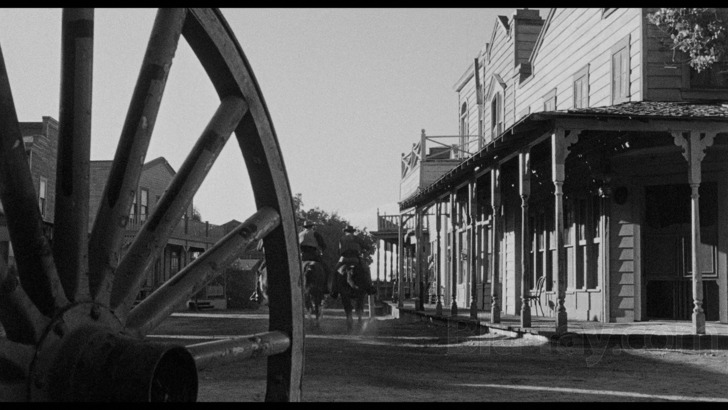
Terror in a Texas Town features an LPCM 2.0 mono track that has a few issues which may bother more persnickety audiophiles, but which most likely won't be a deal killer in any case. There's prevalent hiss throughout this track, which is discernable from the get go and is certainly noticeable in quieter moments. This is the rare Gerald Fried score that I have to say is often pretty unhelpful, and the trumpet cues (which sound like calvary bugler on crack, and, no, I'm not kidding) have slight but persistent distortion. Sound effects resonate relatively clearly but are often lacking oomph in the low end. Dialogue is largely problem free and typically well prioritized.
Terror in a Texas Town Blu-ray Movie, Special Features and Extras 
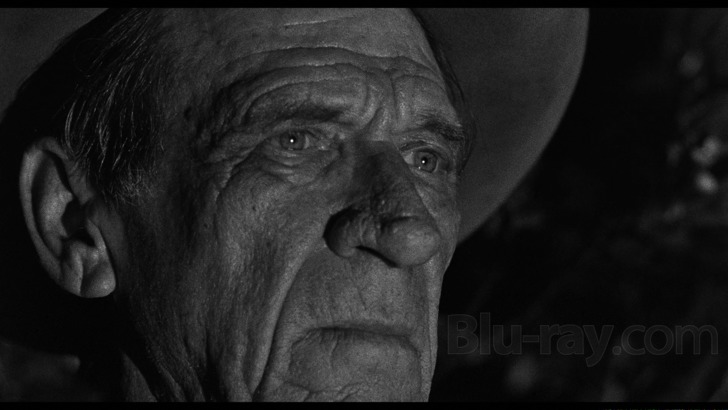
- Introduction by Peter Stanfield (1080p; 13:10) offers Stanfield's thoughts on the assertion that Lewis is a "stylist without a theme".
- A Visual Analysis (1080p; 14:14) offers more of Stanfield's thoughts on the film, this time bolstered by visual examples.
- Theatrical Trailer (1080p; 1:55)
Terror in a Texas Town Blu-ray Movie, Overall Score and Recommendation 
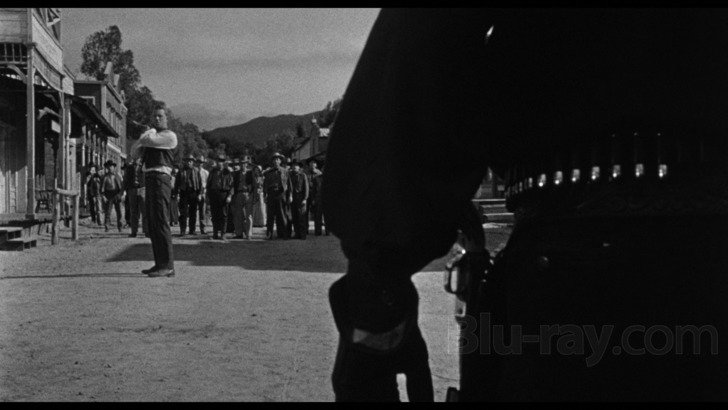
Terror in a Texas Town may not hit the bullseye (with or without a harpoon), but it's kind of weirdly fascinating, featuring some interesting performances and Lewis' inimitable style. Video fares better than audio in this release, and with caveats noted, Terror in a Texas Town comes Recommended.
Similar titles
Similar titles you might also like

Johnny Guitar
1954

Vengeance
1968

Navajo Joe
Special Edition
1966

The Four of the Apocalypse
I quattro dell'apocalisse
1975

A Long Ride from Hell
1968

Cemetery Without Crosses
The Rope and the Colt / Une corde, un Colt...
1969

Nevada Smith
1966

The Great Silence
Il grande silenzio | 50th Anniversary Edition
1968

The Dead Don't Hurt
2024

Texas, Adios
Goodbye Texas
1966

Death Rides a Horse
Da uomo a uomo | Special Edition
1967

3 Bad Men
1926

Day of Anger
Gunlaw / I giorni dell'ira
1967

The Hills Run Red
Un fiume di dollari
1966

The Ballad of Gregorio Cortez
1982

The Grand Duel
Il grande duello / The Big Showdown
1972

Wagon Tracks
1919

The Hired Hand
Arrow Academy
1971

The Specialists
Gli Specialisti
1969

The Return of Ringo
Blood at Sundown / Il ritorno di Ringo
1965

